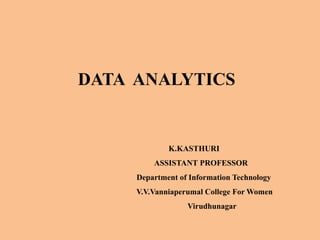data analytics.pptx
•Download as PPTX, PDF•
0 likes•18 views
Overview of Data and Information Difference between Data and Information Types of data Data Strategies
Report
Share
Report
Share

Recommended
Recommended
More Related Content
Similar to data analytics.pptx
Similar to data analytics.pptx (20)
Introduction to Data Analysis for Nurse Researchers

Introduction to Data Analysis for Nurse Researchers
4e75b12ad7d52355111111111111111111111111111111111111

4e75b12ad7d52355111111111111111111111111111111111111
Analysing qualitative data from information organizations

Analysing qualitative data from information organizations
Statistical analysis, presentation on Data Analysis in Research.

Statistical analysis, presentation on Data Analysis in Research.
Trendspotting: Helping you make sense of large information sources

Trendspotting: Helping you make sense of large information sources
More from kasthurimukila
More from kasthurimukila (12)
Blockchain Technology ,Architecture and its Structure

Blockchain Technology ,Architecture and its Structure
Introduction to Database, Purpose of Data, Data models, Components of Database

Introduction to Database, Purpose of Data, Data models, Components of Database
Recently uploaded
https://app.box.com/s/7hlvjxjalkrik7fb082xx3jk7xd7liz3TỔNG ÔN TẬP THI VÀO LỚP 10 MÔN TIẾNG ANH NĂM HỌC 2023 - 2024 CÓ ĐÁP ÁN (NGỮ Â...

TỔNG ÔN TẬP THI VÀO LỚP 10 MÔN TIẾNG ANH NĂM HỌC 2023 - 2024 CÓ ĐÁP ÁN (NGỮ Â...Nguyen Thanh Tu Collection
Mehran University Newsletter is a Quarterly Publication from Public Relations OfficeMehran University Newsletter Vol-X, Issue-I, 2024

Mehran University Newsletter Vol-X, Issue-I, 2024Mehran University of Engineering & Technology, Jamshoro
Recently uploaded (20)
21st_Century_Skills_Framework_Final_Presentation_2.pptx

21st_Century_Skills_Framework_Final_Presentation_2.pptx
HMCS Max Bernays Pre-Deployment Brief (May 2024).pptx

HMCS Max Bernays Pre-Deployment Brief (May 2024).pptx
dusjagr & nano talk on open tools for agriculture research and learning

dusjagr & nano talk on open tools for agriculture research and learning
Food safety_Challenges food safety laboratories_.pdf

Food safety_Challenges food safety laboratories_.pdf
On National Teacher Day, meet the 2024-25 Kenan Fellows

On National Teacher Day, meet the 2024-25 Kenan Fellows
TỔNG ÔN TẬP THI VÀO LỚP 10 MÔN TIẾNG ANH NĂM HỌC 2023 - 2024 CÓ ĐÁP ÁN (NGỮ Â...

TỔNG ÔN TẬP THI VÀO LỚP 10 MÔN TIẾNG ANH NĂM HỌC 2023 - 2024 CÓ ĐÁP ÁN (NGỮ Â...
HMCS Vancouver Pre-Deployment Brief - May 2024 (Web Version).pptx

HMCS Vancouver Pre-Deployment Brief - May 2024 (Web Version).pptx
This PowerPoint helps students to consider the concept of infinity.

This PowerPoint helps students to consider the concept of infinity.
Beyond_Borders_Understanding_Anime_and_Manga_Fandom_A_Comprehensive_Audience_...

Beyond_Borders_Understanding_Anime_and_Manga_Fandom_A_Comprehensive_Audience_...
data analytics.pptx
- 1. DATA ANALYTICS K.KASTHURI ASSISTANT PROFESSOR Department of Information Technology V.V.Vanniaperumal College For Women Virudhunagar
- 2. Objectives Overview of Data and Information Difference between Data and Information Types of data Data Strategies
- 3. Data Data • Data are raw facts and figures that on their own have no meaning • These can be any alphanumeric characters i.e. text, numbers, symbols
- 4. Data Examples • Yes, Yes, No, Yes, No, Yes, No, Yes • 42, 63, 96, 74, 56, 86 • 111192, 111234 • None of the above data sets have any meaning until they are given a CONTEXT and PROCESSED into a useable form
- 5. Data Into Information • To achieve its aims the organisation will need to process data into information. • Data needs to be turned into meaningful information and presented in its most useful format • Data must be processed in a context in order to give it meaning
- 6. Information • Data that has been processed within a context to give it meaning OR • Data that has been processed into a form that gives it meaning
- 11. Data and Information • While data is raw and unorganized, information is organized. • Data points are individual and sometimes unrelated. Information maps out that data to provide a big-picture view of how it all fits together. • Data, on its own, is meaningless.1
- 12. what is data? • Data is a collection of details or data remaining in the form of either figures texts, symbols, descriptions, or mere observations of entities meaningful information.
- 13. Data Information Description Qualitative/ Quantitative variables that present themselves with the potential to be developed into ideas or analytical conclusions. Data that is structured and collated to further its meaning and contextual usefulness. Format Data follows the form of either letters, numbers or characters. Information follows the format of either ideas or references Representation Data is structured either in graphs, data trees, flowcharts, or tables. Information is represented as ideas, thoughts, and languages after collating the data acquired. Meaning Data doesn’t serve any purpose unless given to. Data when interpreted and assigned with some meaning derived out of it, gives information. Interrelation Data is information collected Information is data processed Features Data is raw and doesn’t contain any meaning unless analyzed. Information is data collated and produced to further a logical meaning. Interdependence Data doesn’t depend on information. Information can’t exist without data. Unit Data is measured in bits and bytes. Information if mostly measured in units like quantity, time et al. Use Case for Decision Making Data alone doesn’t pertain to the qualities to help derive decisions. The information contains analytical coherence to help derive a decision. Use Case for Researchers Data acquired by researchers might become useless if they have no analytical inferences to make. Information adds value and usefulness to researchers since they are readily available.
- 14. Types of Data • There are two types of data 1. quantitative 2. qualitative Mixed Data The term mixed refers to the use of both quantitative and qualitative variables.
- 16. Data Strategies • A data strategy is a long-term plan that defines the technology, processes, people, and rules required to manage an organization's information assets. • All types of businesses collect large amounts of raw data today. • Data strategy refers to the tools, processes, and rules that define how to manage, analyze, and act upon business data.